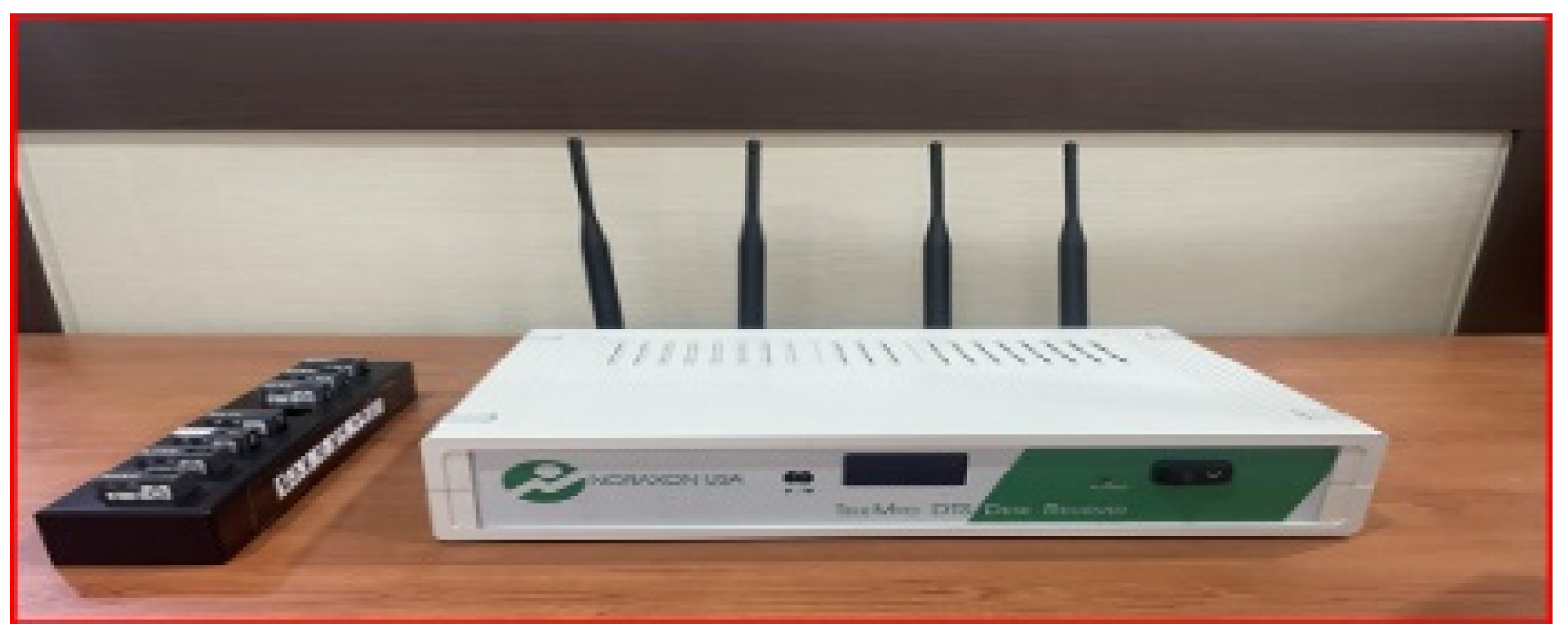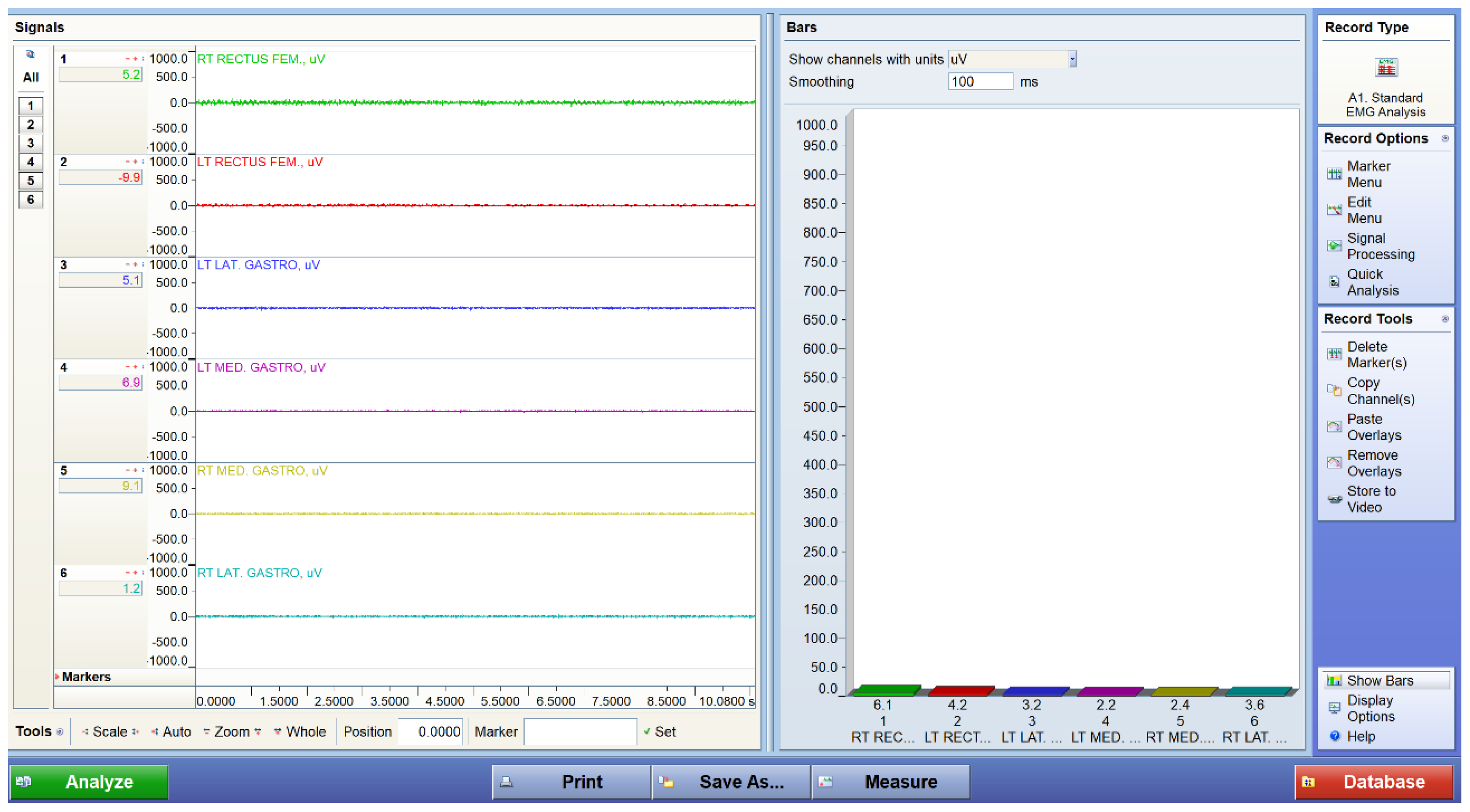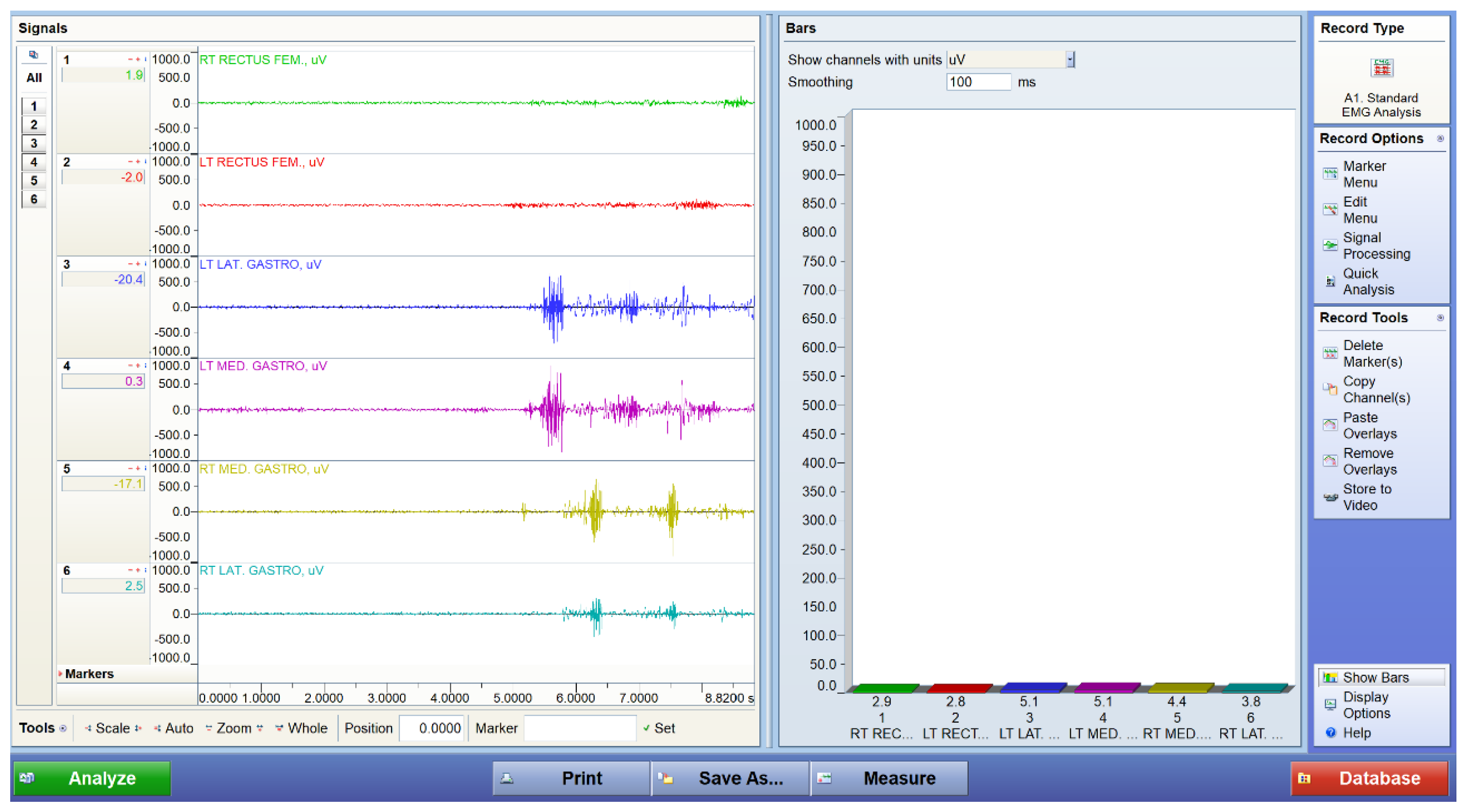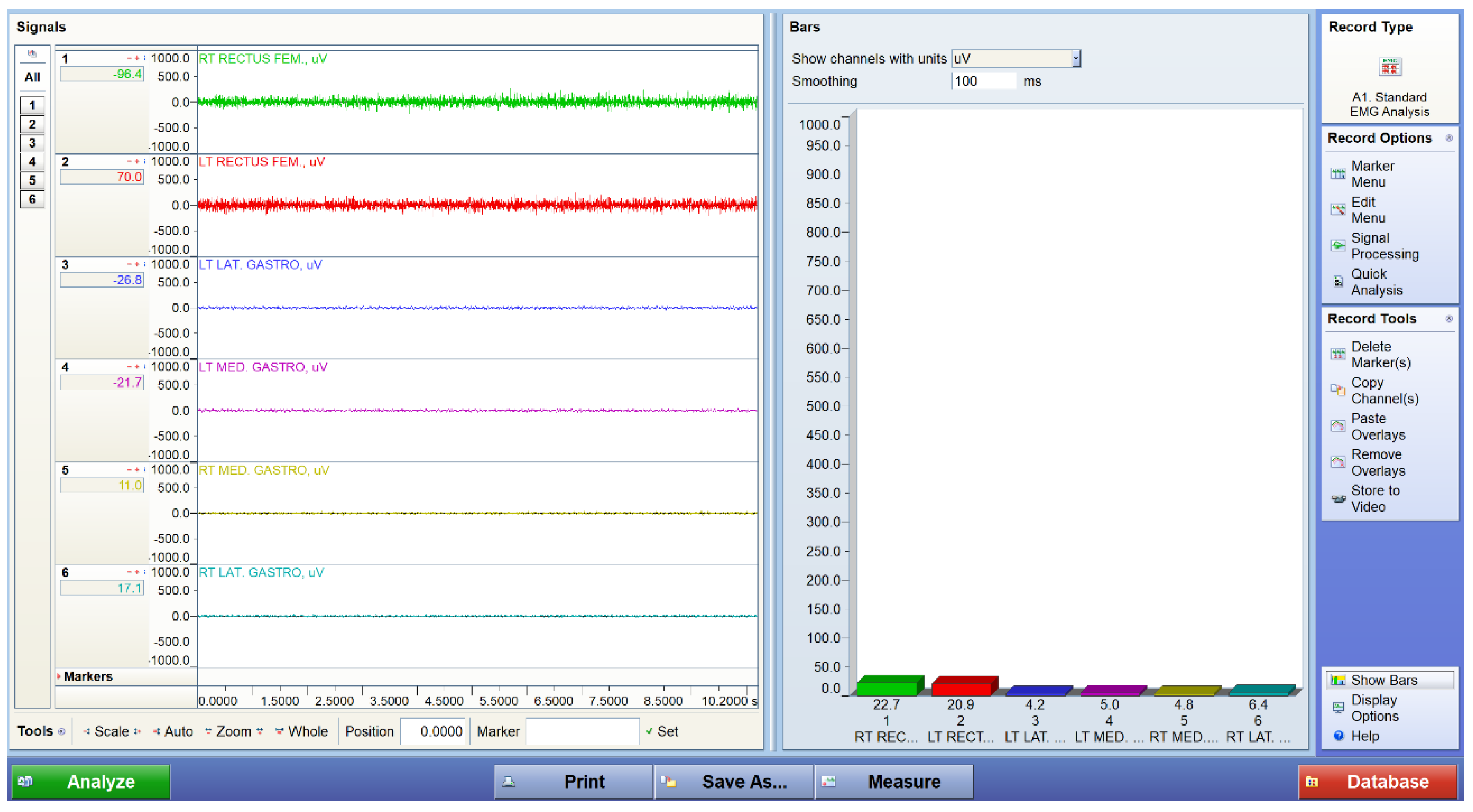1. Introduction
The global COVID-19 pandemic has substantially heightened public awareness of health and wellness, contributing to a marked rise in participation in physical activities such as walking and hiking. In South Korea, the number of individuals engaged in trekking reached 31.69 million in 2021, representing 77% of the adult population—an increase from 71% in 2018. Similarly, the proportion of individuals participating in regular walking activities increased by 9.3%, reaching 68.7% of the population [
1]. These patterns underscore a growing emphasis on physical activity as a strategy for promoting overall well-being and preventing lifestyle-related diseases.
Walking, as a fundamental form of aerobic exercise, is critical for maintaining cardiovascular health and musculoskeletal function. Current guidelines recommend that adults perform at least 150 min of moderate-intensity aerobic activity per week to sustain optimal health [
2]. Compared with other structured exercises, walking is highly accessible, requiring no specialized equipment and minimal training, thus serving as an effective intervention for individuals with limited time or mobility constraints [
3]. However, the benefits derived from walking can be influenced by footwear design, surface conditions, and supplementary mechanical stimuli such as whole-body vibration (WBV).
The feet play a vital role in postural stability and locomotor mechanics. They contain a dense network of peripheral nerves that facilitate proprioception, balance, and circulation. Despite being anatomically the farthest from the heart, the feet assist venous return and are often referred to as the “secondary heart” [
4]. Footwear is integral to maintaining efficient biomechanics during walking and running by enhancing shock absorption, supporting posture, and preventing excessive loading on the lower extremities. In contrast, poorly designed footwear, or shoes lacking adequate stability and cushioning, may induce abnormal gait patterns, hyperpronation, and elevated stress on the Achilles tendon, ligaments, and ankle joints [
5,
6,
7].
Recent advancements in exercise technology have introduced vibrating sneakers as an innovative approach to enhance muscle activation and circulation during walking. WBV, traditionally delivered through stationary vibration platforms, has been extensively studied for its capacity to stimulate neuromuscular function, improve proprioception, and augment muscle performance [
8,
9]. Evidence suggests that WBV may be particularly beneficial for populations with mobility impairments, such as older adults and stroke survivors, by providing additional mechanical stimuli that enhance muscle strength, circulation, and postural control [
10,
11].
A recent network meta-analysis by Liu et al. [
12] comprehensively compared the effects of WBVT with different frequencies on balance ability in older adults. Including 25 RCTs with 1267 subjects, the study found that low-frequency WBVT (LF-WBVT, <30 Hz) significantly improved outcomes in the Timed Up and Go Test (TUGT) compared with placebo and traditional rehabilitation groups. Although medium- and high-frequency WBVT also showed trends toward improvements, only HF-WBVT ranked highest in cumulative probability for enhancing balance, suggesting that frequency selection is crucial for optimizing outcomes. Importantly, the findings reinforce that LF-WBVT is both effective and safe for older adults, consistent with recommendations for populations at higher risk of musculoskeletal strain. Complementing this, Yu and Kwon [
13] demonstrated that a structured WBV exercise program significantly enhanced physical performance and postural balance in older adults, with notable improvements in lower-limb muscle strength, cardiovascular endurance, and dynamic stability tests such as OLS and TUG. Their findings further support the utility of WBV as an elderly-friendly intervention that is both effective and low-impact. Similarly, Chung et al. [
14] showed that different WBV frequency–amplitude combinations, even under the same acceleration, elicited distinct neuromuscular adaptations in young adults, with high-frequency/low-amplitude protocols improving isometric and isokinetic strength, while medium-frequency settings enhanced both concentric and eccentric contractions. These results highlight that frequency–amplitude parameters critically shape WBV outcomes, reinforcing the rationale for selecting low-frequency wearable devices (e.g., 18 Hz sneakers) in middle-aged and older populations, where safety and adaptability are key considerations.
However, the physiological effects of wearable WBV devices, such as vibrating sneakers, remain relatively underexplored compared to those of traditional stationary WBV platforms. Existing research indicates that WBV can induce muscle relaxation at specific frequencies, with the most pronounced effect observed at 16 Hz [
15]. Nevertheless, only a limited number of studies have examined how continuous WBV exposure during walking influences muscle activation patterns. Furthermore, the integration of WBV with dynamic movements, such as squatting, may further enhance strength development, as prior evidence has demonstrated that WBV combined with resistance training yields greater strength improvements than resistance training alone [
8,
16]. In addition, WBV has been associated with increased bone mineral density [
17] and reductions in body fat percentage [
18,
19], positioning it as a promising modality for enhancing overall musculoskeletal health.
Despite these reported benefits, WBV is not without risks. Prolonged or excessive exposure to high-intensity vibrations has been linked to adverse effects on biological tissues, including neuromuscular fatigue and microtrauma [
10]. Nevertheless, when appropriately applied, WBV has been shown to serve as an effective intervention for fall prevention in older adults, as it improves muscle coordination and balance [
9]. Importantly, neuromuscular responses to WBV vary according to frequency, amplitude, and individual training status, with evidence suggesting that optimal muscle activation occurs at specific vibration frequencies. For example, a study comparing vibration frequencies of 8 Hz, 26 Hz, and 40 Hz reported significant improvements in muscle strength only at 26 Hz [
20]. Moreover, WBV has demonstrated effectiveness in clinical populations; for instance, in individuals with shoulder instability, higher-frequency and higher-amplitude WBV enhanced serratus anterior activation [
21].
Muanjai et al. [
22] investigated how WBV frequency affects muscle stiffness in the medial gastrocnemius (MG) and soleus (SOL) during plantar flexor isometric contractions. Using shear wave elastography, they showed that 24 Hz WBV significantly increased MG shear wave speed (muscle stiffness) at rest, while SOL exhibited a small reduction during contraction. Additionally, subjective ratings indicated increased stiffness after 12 Hz, and pennation angle decreased in MG during contraction after 24 Hz WBV. These results suggest that frequency-specific WBV induces differential neuromuscular responses within the triceps surae muscles and that shear wave elastography may be a useful tool for assessing acute changes in muscle mechanical properties. Importantly, the findings highlight that gastrocnemius and soleus respond differently to WBV depending on vibration frequency and contraction state, reinforcing the need to analyze specific lower-limb muscles when evaluating WBV interventions.
Traditionally, resistance training has served as the primary modality for enhancing muscle strength and power. However, this form of training requires substantial physical effort and is associated with a heightened risk of injury, particularly among older adults and individuals with pre-existing musculoskeletal conditions. In contrast, whole-body vibration (WBV) has emerged as a lower-impact alternative capable of eliciting comparable neuromuscular benefits while minimizing injury risk. Consequently, WBV has attracted growing attention as a potentially safer and more efficient training strategy, offering a promising complement or substitute for conventional resistance-based interventions [
8,
23,
24,
25,
26].
Recent literature highlights that the physiological responses to whole-body vibration training (WBVT) are frequency dependent, typically classified as low-frequency WBVT (LF-WBVT, <30 Hz), medium-frequency WBVT (MF-WBVT, ≥30 Hz to <45 Hz), and high-frequency WBVT (HF-WBVT, >45 Hz) [
27,
28,
29]. Studies have suggested that low-frequency WBV (<30 Hz) is often recommended for older adults and clinical populations due to its safer profile and reduced risk of musculoskeletal strain [
30,
31]. Accordingly, the wearable vibrating sneakers used in the present study were designed to operate at 18 Hz, a frequency within the low-frequency range, in order to balance effectiveness in stimulating muscle activation with safety and long-term feasibility for middle-aged populations.
While prior research has extensively investigated the effects of WBV administered through stationary platforms, relatively few studies have examined how wearable WBV technologies—such as vibrating sneakers—affect muscle activation during dynamic movements like walking and squatting. To address this gap, the present study evaluated the impact of vibrating sneakers operating at 18 Hz on lower-limb muscle activation in both exercising and non-exercising middle-aged adults. Specifically, the study assessed whether wearing vibrating sneakers during walking and squatting enhances neuromuscular engagement compared with conventional footwear.
Moreover, some manufacturers have claimed that WBV training at 25 Hz can generate muscle activation equivalent to walking 10,000 steps within just seven minutes. However, such claims remain largely unsupported by empirical evidence and are often employed as marketing strategies, contributing to consumer confusion. This underscores the need for rigorous scientific evaluation of wearable WBV devices. In this study, participants were divided into an exercise group (walking for 30 min, three times per week) and a non-exercise group, each further stratified into subgroups wearing or not wearing vibrating sneakers set at 18 Hz. Over a 16-week intervention, muscle activity was measured to evaluate changes in neuromuscular activation during both walking and squatting.
By systematically examining the effects of vibrating sneakers in these conditions, this study contributes empirical evidence to the expanding field of WBV applications. The findings provide new insights into the efficacy and limitations of wearable WBV devices in enhancing neuromuscular function, offering valuable implications for athletes, fitness professionals, rehabilitation specialists, and wearable sensor developers.
3. Results
3.1. Muscle Activity During Walking—Exercise Group
This section presents the analysis of muscle activity before and after walking in the exercise group, which was divided into participants wearing and not wearing vibrating sneakers (18 Hz) over a 16-week intervention (walking 30 min, three times per week).
As shown in
Table 1, significant differences were observed in the quadriceps muscle after walking with vibrating sneakers. The right quadriceps muscle showed a decrease in muscle activity from 49.29 ± 38.06 to 24.48 ± 22.72 (
t = 2.86,
p = 0.012), while the left quadriceps muscle decreased from 40.08 ± 32.97 to 21.15 ± 20.30 (
t = 2.61,
p = 0.021). These results suggest that walking with vibrating sneakers may reduce the need for excessive muscle activation, potentially improving neuromuscular efficiency.
In contrast, no significant differences were found in the gastrocnemius muscle. The right gastrocnemius muscle changed minimally from 28.11 ± 8.67 to 28.24 ± 11.10 (t = −0.04, p = 0.969), while the left gastrocnemius muscle changed from 57.16 ± 28.27 to 58.03 ± 20.65 (t = −0.13, p = 0.891). Similarly, for the left leg, no statistically significant changes were found in gastrocnemius activation, indicating that vibrating sneakers may have a more pronounced effect on proximal rather than distal muscle groups.
For the group not wearing vibrating sneakers (
Table 2), no significant differences were observed across all measured muscles. The right quadriceps muscle activity decreased slightly from 19.22 ± 12.26 to 17.74 ± 7.56 (
t = 0.562,
p = 0.583), while the left quadriceps muscle showed a non-significant decrease from 29.32 ± 21.47 to 21.52 ± 9.57 (
t = 1.635,
p = 0.124). The gastrocnemius muscles also exhibited minor fluctuations, but none reached statistical significance.
The results indicate that wearing vibrating sneakers (18 Hz) while walking significantly impacts quadriceps activation but does not affect gastrocnemius activation. This suggests that vibration exposure may alter neuromuscular recruitment patterns, particularly in the proximal muscles, potentially improving muscle efficiency. However, since no significant effects were observed in the gastrocnemius, future research should explore whether frequency adjustments or prolonged usage impact distal muscles differently. These findings provide preliminary evidence supporting the use of vibrating sneakers for lower-limb muscle activation modulation in walking-based exercise interventions.
3.2. Muscle Activity During Walking—Non-Exercise Group
This study examines the muscle activity before and after walking in the non-exercise group, which was divided into participants wearing and not wearing vibrating sneakers (18 Hz) over a 16-week period.
As shown in
Table 3, participants in the non-exercise group who wore vibrating sneakers exhibited significant increases in muscle activation across multiple muscle groups. The right quadriceps increased from 27.79 ± 15.62 to 29.91 ± 13.23 (
t = 2.153,
p = 0.049), and the left quadriceps showed a similar increase from 22.66 ± 15.20 to 25.25 ± 13.62 (
t = 2.270,
p = 0.040). This suggests that even in the absence of an active exercise regimen, wearing vibrating sneakers can stimulate muscle activation during walking. In addition to the quadriceps, the gastrocnemius muscles showed notable activation changes. The right gastrocnemius muscle increased from 26.06 ± 10.11 to 30.11 ± 7.95 (
t = 2.702,
p = 0.017), and the left gastrocnemius muscle demonstrated a statistically significant increase from 25.32 ± 14.03 to 29.60 ± 12.77 (
t = 2.626,
p = 0.020). These results indicate that the application of whole-body vibration through footwear may enhance lower-limb muscle engagement even without structured physical activity.
For the group that did not wear vibrating sneakers (
Table 4), the results were markedly different. Significant reductions in quadriceps activity were observed, with the right quadriceps decreasing from 42.76 ± 32.66 to 15.80 ± 8.17 (
t = 3.809,
p = 0.001) and the left quadriceps decreasing from 45.86 ± 34.81 to 14.75 ± 5.71 (
t = 3.961,
p = 0.001). These findings suggest that without vibration-induced stimulation, muscle activation during walking may decline over time in a non-exercise setting. Conversely, no significant changes were observed in the gastrocnemius muscles. The right gastrocnemius muscle showed a non-significant decrease from 30.08 ± 13.16 to 24.56 ± 9.01 (
t = 1.392,
p = 0.181), while the left gastrocnemius muscle remained relatively stable (
t = 0.797,
p = 0.436). This indicates that the absence of vibration exposure may primarily affect the quadriceps, whereas gastrocnemius activity appears less dependent on external stimulation.
The results suggest that wearing vibrating sneakers (18 Hz) can help maintain or increase lower-limb muscle activation even in individuals who are not actively exercising. This effect is particularly evident in the quadriceps and gastrocnemius muscles, supporting previous research indicating that whole-body vibration may enhance neuromuscular engagement. On the other hand, the decline in quadriceps activity observed in the non-vibrating sneaker group highlights the potential risk of muscle deconditioning in sedentary individuals. These findings may have implications for the development of passive exercise interventions aimed at preventing muscle decline in non-active populations.
3.3. Muscle Activity During Squat—Exercise Group
This section presents the results of muscle activity before and after the squat movement in the exercise group, which was divided into participants wearing and not wearing vibrating sneakers (18 Hz) over a 16-week period.
As shown in
Table 5, participants who performed squats while wearing vibrating sneakers exhibited significant increases in quadriceps activation. The right quadriceps increased from 69.84 ± 27.27 to 79.90 ± 27.90 (
t = 2.333,
p = 0.035), while the left quadriceps showed a similar increase from 68.92 ± 31.69 to 89.20 ± 46.51 (
t = 2.227,
p = 0.043). These findings suggest that vibration exposure during squatting may enhance neuromuscular engagement, potentially improving lower-limb strength. Additionally, significant changes were observed in the gastrocnemius muscles. The left gastrocnemius increased from 7.63 ± 2.85 to 9.75 ± 4.01 (
t = 2.681,
p = 0.018), while the right gastrocnemius increased from 6.60 ± 2.69 to 7.50 ± 2.29 (
t = 2.347,
p = 0.034). The most substantial improvement was observed in the left gastrocnemius muscle (L), which increased from 8.36 ± 4.21 to 9.74 ± 3.77 (
t = 3.428,
p = 0.004), indicating a more pronounced response to vibration-induced stimulation.
For the group that did not wear vibrating sneakers (
Table 6), the results were less pronounced. The right quadriceps showed a minor increase from 61.02 ± 21.07 to 63.56 ± 23.52 (
t = 0.744,
p = 0.469), while the left quadriceps increased from 63.68 ± 20.58 to 73.48 ± 30.39 (
t = 1.763,
p = 0.100). However, these changes were not statistically significant, suggesting that traditional squatting without vibration may not elicit substantial neuromuscular adaptations over the 16-week period. In the gastrocnemius muscles, only the left gastrocnemius (R) showed a significant increase from 7.45 ± 3.19 to 8.44 ± 3.51 (
t = 2.270,
p = 0.040). Other measurements, including right and left gastrocnemius (L), did not exhibit significant changes.
The findings suggest that wearing vibrating sneakers (18 Hz) during squat movements leads to significantly greater muscle activation, particularly in the quadriceps and gastrocnemius muscles. This aligns with previous research indicating that whole-body vibration can enhance neuromuscular stimulation, potentially improving strength and endurance. In contrast, the absence of vibration exposure resulted in limited improvements, particularly in quadriceps activation. These results highlight the potential benefits of integrating vibrating footwear into resistance training protocols to optimize muscle engagement during lower-limb exercises.
3.4. Muscle Activity During Squat—Non-Exercise Group
This section examines the muscle activity before and after squatting in the non-exercise group, which was divided into participants wearing and not wearing vibrating sneakers (18 Hz) over a 16-week period.
As shown in
Table 7, significant changes were observed in quadriceps activation for participants who wore vibrating sneakers. The right quadriceps muscle exhibited a decrease in activation from 76.39 ± 37.49 to 68.54 ± 34.82 (
t = 3.688,
p = 0.002), while the left quadriceps increased from 78.89 ± 39.22 to 87.28 ± 36.39 (
t = 2.497,
p = 0.026). These findings suggest that vibration exposure may differentially affect muscle engagement, potentially enhancing neuromuscular coordination and efficiency. In contrast, the gastrocnemius muscles did not show statistically significant improvements. The right gastrocnemius increased slightly from 8.59 ± 3.68 to 9.69 ± 4.19 (
t = 1.893,
p = 0.079), while the left gastrocnemius increased from 6.65 ± 1.38 to 7.10 ± 2.40 (
t = 0.867,
p = 0.400). Similarly, no significant differences were found in the left gastrocnemius (L) (
t = 0.546,
p = 0.594) and right gastrocnemius (L) (
t = 1.555,
p = 0.142), indicating that whole-body vibration in a non-exercise setting may have a more limited effect on the lower-leg muscles.
For the group that did not wear vibrating sneakers (
Table 8), no significant differences were observed across all measured muscles. The right quadriceps showed a slight increase from 68.14 ± 31.73 to 69.01 ± 29.76 (
t = 0.226,
p = 0.823), and the left quadriceps increased from 62.12 ± 21.62 to 68.09 ± 21.93 (
t = 1.549,
p = 0.139), but neither change reached statistical significance. Similarly, gastrocnemius activation remained relatively unchanged. The right gastrocnemius showed a non-significant change from 7.81 ± 5.49 to 7.51 ± 2.66 (
t = 0.266,
p = 0.793), while the left gastrocnemius exhibited a minimal increase from 7.35 ± 4.02 to 7.71 ± 3.24 (
t = 0.579,
p = 0.570). The left gastrocnemius (L) approached significance, increasing from 6.48 ± 2.76 to 7.70 ± 3.08 (
t = 2.023,
p = 0.058), but this result suggests only a marginal improvement.
The findings indicate that wearing vibrating sneakers (18 Hz) may enhance quadriceps activation during squat movements, even in individuals who do not engage in regular exercise. However, the lack of significant effects on the gastrocnemius muscles suggests that passive exposure to vibration alone may not be sufficient to induce lower-leg muscle adaptations. These results align with prior research emphasizing that whole-body vibration is most effective when combined with dynamic movements. The minimal changes observed in the non-vibrating sneaker group highlight the potential for muscle deconditioning in sedentary populations, reinforcing the importance of incorporating external stimulation methods, such as vibration-based interventions, to maintain muscle engagement.
4. Discussion
This study aimed to investigate the impact of wearing vibrating sneakers (18 Hz) on muscle activation during walking and squatting over a 16-week period. The participants were divided into four groups: an exercise group (walking for 30 min, three times per week) and a non-exercise group, with each group further divided into those wearing and not wearing vibrating sneakers. The study findings were analyzed in comparison with existing literature on whole-body vibration exercise, muscle activation, and neuromuscular adaptation.
WBV training has been widely studied for its effects on neuromuscular activation and performance enhancement. Previous research has suggested that WBV can stimulate muscle spindles and Golgi tendon organs, leading to reflex muscle contractions that improve strength, balance, and muscle endurance [
36]. This mechanism is particularly useful for populations with limited mobility, as WBV can mimic traditional exercise effects without requiring significant voluntary movement [
10]. Additionally, WBV has been shown to improve proprioception, which is crucial for balance and injury prevention [
25]. The current study found significant differences in quadriceps activation in both the exercise and non-exercise groups when wearing vibrating sneakers, supporting prior findings that WBV can enhance lower-limb muscle activity [
8]. This effect was particularly pronounced during squatting, where vibration stimulation likely increased neuromuscular recruitment and synchronization [
37]. The significant activation of the quadriceps muscles aligns with previous findings that WBV is more effective for proximal muscles than distal muscles, likely due to differences in muscle fiber composition and neuromuscular control [
17].
In the exercise group, wearing vibrating sneakers resulted in significantly reduced quadriceps muscle activation after walking. While this reduction may suggest improved neuromuscular efficiency—where less activation is required to achieve the same movement—we acknowledge that alternative explanations such as transient muscle fatigue or reduced motor unit recruitment cannot be completely ruled out. Our findings are consistent with prior studies reporting that WBV can reduce energy expenditure and optimize neuromuscular coordination during locomotor activities [
38,
39,
40,
41]. However, no significant changes were observed in gastrocnemius activation, suggesting that WBV may primarily influence proximal muscles during dynamic movements. The gastrocnemius muscle is heavily involved in plantarflexion and push-off during walking, but it may not experience the same level of vibration-induced activation as the quadriceps, which play a dominant role in knee extension and shock absorption [
16]. These findings are consistent with prior research suggesting that WBV-induced adaptations are more pronounced in larger muscle groups with higher neuromuscular demand [
11]. In contrast, in the non-exercise group, wearing vibrating sneakers led to significant increases in both quadriceps and gastrocnemius activation. This suggests that for individuals without regular exercise, WBV exposure may compensate for the lack of active training by enhancing neuromuscular activation [
10]. The increased gastrocnemius activity in this group may be due to the absence of prior neuromuscular conditioning, which allows for greater adaptive responses compared to an active population [
8].
During squatting, significant increases in quadriceps and gastrocnemius activation were observed in both the exercise and non-exercise groups wearing vibrating sneakers. The squat movement requires substantial lower-limb strength, particularly in the quadriceps and gastrocnemius muscles, which are responsible for knee extension and ankle plantarflexion, respectively [
42]. The enhanced activation of these muscles aligns with studies indicating that WBV can increase muscle force production and improve postural control [
37]. One possible explanation for these findings is the tonic vibration reflex (TVR), which occurs when vibration stimulates muscle spindles, resulting in enhanced motor unit recruitment and increased force output [
36]. This mechanism has been shown to be particularly effective during resistance training exercises such as squats, where WBV can amplify muscle activation and improve overall performance [
14]. Interestingly, while significant improvements were observed in the vibrating sneaker groups, the non-vibrating sneaker groups showed little to no changes in muscle activation. This finding supports prior research suggesting that traditional squatting without additional stimulation may not induce substantial neuromuscular adaptations over short- to medium-term periods [
26]. In contrast, adding WBV appears to accelerate neuromuscular adaptations, likely due to increased afferent feedback and central nervous system involvement [
9].











